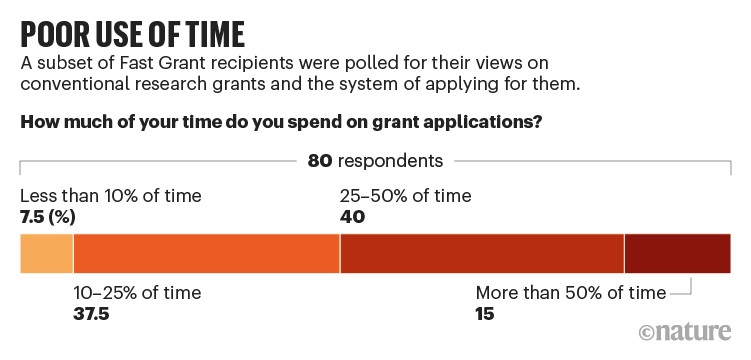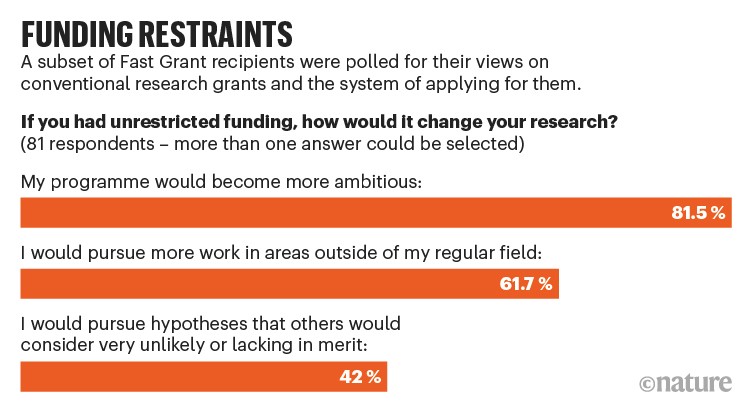COVID ‘Fast Grants’ sped up pandemic science
What happened when an economics researcher, a bioengineer and a tech entrepreneur joined forces in a pandemic? They envisaged a research-grant system with an application form that can be completed in less than 30 minutes, a decision-making process that takes just 48 hours, and funding that arrives within a week — and then set up the system in 10 days, using donations from philanthropists.
The scheme, known as Fast Grants, launched in April 2020 and received 4,000 applications in its first week. It was created by Tyler Cowen, an economics researcher at George Mason University in Fairfax, Virginia; Patrick Collison, co-founder of online payment processing platform, Stripe; and Patrick Hsu, a bioengineer at the University of California, Berkeley.
Now the trio have released the results of a survey about how the speedy funding benefited scientists’ work in the early stages of the COVID-19 pandemic and how traditional routes of funding may be overly bureaucratic.
Lethargic response
The conventional process of securing research funding typically takes more than a year; even fast-track schemes can take months. The institutional response to the pandemic “has been lethargic”, write the trio in a blog post about the scheme. They note that in early 2020, they “expected the U.S.’s immense government funding systems to be unleashed, with decisions made in days if not in hours. This is what happened during World War II, which killed fewer Americans.”
Instead, Tyler, Collison and Hsu found that leading scientists were “stuck on hold”, waiting for permission from funders to repurpose projects to tackle COVID-19.
In response, they set up Fast Grants, securing more than US$50 million from donors. By the end of 2020, they had issued 260 grants, mostly to labs in the United States, but also in Japan, Australia, Germany and the United Kingdom.
Projects were awarded across many topics. One supported research that found saliva swabs worked just as well as nasopharyngeal swabs did for SARS-CoV-2 tests. Others tracked viral variants of concern before the advent of genomic surveillance systems, and identified misfired immune responses in people with severe COVID-19.
According to a survey of 80 of the grant recipients, 67% said their research wouldn’t have been possible without a fast grant, and about a third said it accelerated their work by months.
The data shows that “our current grant system is too slow, too restrictive and inflexible”, says Cowen, who is also the director of Fast Grants. However, he acknowledges the existing system has achieved a lot in battling COVID, for example much of the work on mRNA vaccines has been funded by US National Institute of Health grants.
Shahar Avin, a philosopher at the University of Cambridge, UK, agrees, saying that the interest in the scheme and the survey results suggest there is “significant untapped potential for research”. But one important question to be answered is whether the Fast Grants projects “generate results that are as high in quality and impact as more traditional streams”, he says.
Some studies actually suggest that these types of fast projects can have a greater impact than those funded through more conventional, slower, routes1.
The speed of the Fast Grants application and approval process was possible thanks to an innovative review system . A group of 20 early career researchers from different institutions vetted the more than 6000 proposals submitted by laboratory heads. At least three reviewers read each application, and funding was awarded if one or two reviewers, at least, thought it was very worthy of funding.
While the approval process took less than 48 hours initially, it later took up to two weeks in some cases, once the scheme became more popular.
Huge drain on time
Normally, grant applications pass through the hands of tens of reviewers. At the US National Institutes of Health, for example, funded proposals typically go through three phases of review and are appraised by 10–20 scientists and programme officers in total.
More than 55% of those who replied to the Fast Grants survey said they spent more than one-quarter of their working hours putting together grant applications, highlighting how conventional mechanisms are a huge drain on researchers’ time (see ‘Poor use of time’).
“This seems crazy. We spend enormous effort training scientists who are then forced to spend a significant fraction of their time seeking alms instead of focusing on the research they’ve been hired to pursue,” write Cowen, Collison and Hsu.
When asked how having unconstrained, permanent funding would affect their science, almost 80% of respondents said it would change their research programme a lot (see ‘Funding restraints’). The top changes they cited included making projects more ambitious, working outside their usual field and pursuing hypotheses that others thought to be unlikely or lacking in merit.
Donna Ginther, an economist at the University of Kansas in Lawrence, says that governmental funding routes are time-consuming and cautious because taxpayers’ money is being spent. “Public funders have a much lower tolerance for failure, which results in a more conservative and rigorous peer-reviewed approach,” she says.
doi: https://doi.org/10.1038/d41586-021-02111-7
References
- 1.
Guthrie, S., Ghiga, I. & Wooding, S. F1000Research 6, 1335 (2018).



No comments:
Post a Comment